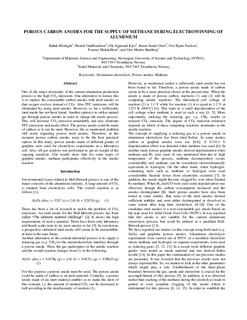| dc.contributor.author | Khalaghi, Babak | |
| dc.contributor.author | Gudbrandsen, Henrik | |
| dc.contributor.author | Kjos, Ole Sigmund | |
| dc.contributor.author | Osen, Karen Sende | |
| dc.contributor.author | Paulsen, Ove | |
| dc.contributor.author | Mokkelbost, Tommy | |
| dc.contributor.author | Haarberg, Geir Martin | |
| dc.date.accessioned | 2017-11-01T08:05:29Z | |
| dc.date.available | 2017-11-01T08:05:29Z | |
| dc.date.created | 2017-03-22T08:40:34Z | |
| dc.date.issued | 2017 | |
| dc.identifier.citation | Light Metals. 2017, 1333-1339. | nb_NO |
| dc.identifier.issn | 0147-0809 | |
| dc.identifier.uri | http://hdl.handle.net/11250/2463325 | |
| dc.description.abstract | One of the major downsides of the current aluminium production process is the high CO2 emission. One alternative is to replace the consumable carbon anodes with inert anodes so that oxygen evolves instead of CO2. Also PFC emissions will be eliminated by using inert anodes. However, so far a sufficiently inert anode has not been found. Another option is to utilize natural gas through porous anodes in order to change the anode process. This will decrease CO2 emission remarkably and also eliminate PFC emissions and anode effect. The porous anode could be made of carbon or it can be inert. However, the as-mentioned problem still exists regarding porous inert anodes. Therefore, at the moment porous carbon anodes seem to be the best practical option. In this study, porous anodes made of different grades of graphite were used for electrolysis experiments in a laboratory cell. Also, off-gas analysis was performed to get an insight of the ongoing reactions. Our results show that for some types of graphite anodes, methane participates effectively in the anodic reaction. | nb_NO |
| dc.language.iso | eng | nb_NO |
| dc.publisher | Springer Verlag | nb_NO |
| dc.title | Gas Anodes Made of Porous Graphite for Aluminium Electrowinning | nb_NO |
| dc.type | Journal article | nb_NO |
| dc.description.version | acceptedVersion | nb_NO |
| dc.source.pagenumber | 1333-1339 | nb_NO |
| dc.source.journal | Light Metals | nb_NO |
| dc.identifier.doi | 10.1007/978-3-319-51541-0_159 | |
| dc.identifier.cristin | 1460217 | |
| dc.description.localcode | © The Minerals, Metals & Materials Society 2017. The final publication is available at https://link.springer.com/chapter/10.1007/978-3-319-51541-0_159. This is the authors' accepted and refereed manuscript to the article. | nb_NO |
| cristin.unitcode | 194,66,35,0 | |
| cristin.unitname | Institutt for materialteknologi | |
| cristin.ispublished | true | |
| cristin.fulltext | preprint | |
| cristin.qualitycode | 1 | |
